It has been interesting times in the Search Engine Optimisation world this year. As analysts, we have seen some of the greatest shifts and movements in rankings since 2012 where Google introduced updates such as Panda, Penguin and then Hummingbird which represented a huge shift in the way their algorithm worked.
When these changes were made businesses, analysts and SEO experts alike scrambled to understand the impact of these changes and what needed to be done in order to manage any potential fallout.
In 2018, we are seeing similar (if not larger) shifts in rankings and, moreover, entire changes in the way Google produces search results.
Often, we find that the changes will not affect sites that are well optimised to begin with but in this case, we have seen with most of our clients not necessarily drops in ranking and search but rather fluctuation in position and organic traffic that is very inconsistent.
It has made understanding a root cause difficult, also making updates difficult to accurately measure impact.
It is easy to see that we are not the only company who is aware of this. By simply reviewing tools such as Mozcast and Accuranker we can see that the algorithm is in serious flux.
2018 Updates
February 20, 2018: Unnamed Update – Unconfirmed
There was a noted spike in volatility that occurred in multiple monitoring tools but which quickly settled down. This sometimes signals a targeted algorithm update. Google did not confirm an update at this time
March 8, 2018: “Brackets” Core update – Confirmed
On March 7th 2018 Google confirmed a core update. Impacts though were seen as early as the 4th of March and continued for almost two weeks as a rolling update. It was named “Brackets” by Glenn Gabe.
Although no details were provided by Google, analysts believe the change affected a sites Rich Snippets which could either disappear or suddenly gain in position. Suggested solutions included high-quality content production to gain links from well-known sites, cutting down on unnecessary, aggressive or deceptive advertising and focusing on site usability.
The last makes perfect sense as Google has been strongly emphasizing aspects such as mobile usability and site speed. A key example is an introduction of Accelerated Mobile Pages (AMP) from Google that allowed for the addition of a lower load size for mobile devices.
In short, it is suggested that the “Brackets” update specifically targeted low-value content and usability sites.
The below twitter conversation between Barry Schwartz from seroundtable.com and Danny Sullivan from Google shows that we don’t know exactly what the changes were:
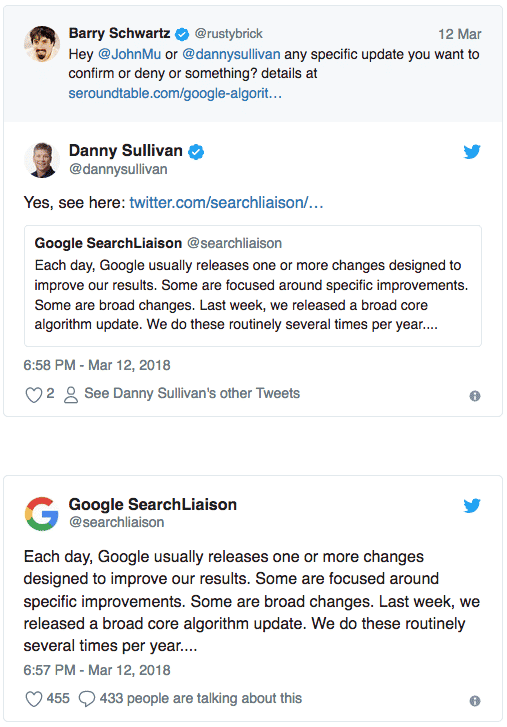
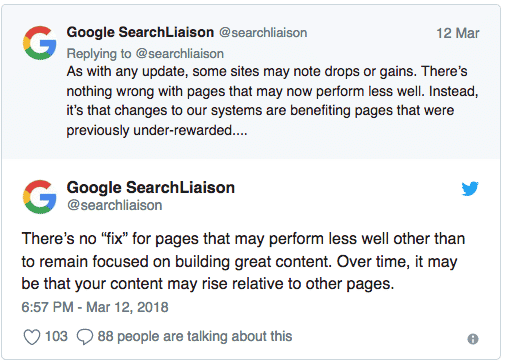
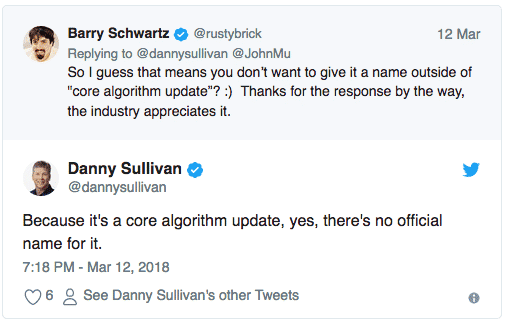



March 14, 2018: Zero-SERP (Search Engine Results Page) test – Unconfirmed
A very interesting update (and somewhat challenging) was a test on a small set of Knowledge Cards Google ran including some time/date queries and unit conversion calculators where Google showed only the card and a button for “Show all results”. Of course, this means that the user would not have travelled to a website but rather completed their search need inside the search result.
As we can see this could be exceptionally problematic for organic search ranking if Google provides the required content directly in a search result without a user needing to travel to the associated site.
The test was stopped but there is a suggestion that this is an important sign of things to come.
Dr Peter Myers writes a great piece on this which you can read here: Zero-Result SERPs: Welcome to the Future We Should’ve Known Was Coming
March 26, 2018: Mobile-First Index Roll-Out – Confirmed
We have been expecting it for a while now as Google consistently focused on Mobile device compatibility and usability when it came to ranking a site. Now Google has officially announced that it has rolled out the Mobile-First index and will be migrating sites gradually to the new index
As a recap from google:
“To recap, our crawling, indexing, and ranking systems have typically used the desktop version of a page’s content, which may cause issues for mobile searchers when that version is vastly different from the mobile version. Mobile-first indexing means that we’ll use the mobile version of the page for indexing and ranking, to better help our – primarily mobile – users find what they’re looking for. “
We surmise that this means sites who have not moved towards a mobile-first practice will begin to suffer in the mobile rankings even more so than they have been.
June 13, 2018: Speculative update – Unconfirmed
Most recently we have seen huge volatility in the Google index across many tools and causing many webmaster and SEOs to nearly pull their hair out trying to understand these changes.
Below are some of the shifts that we have seen:


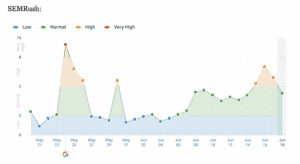
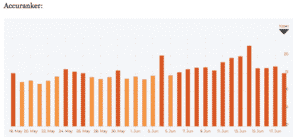
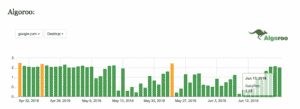
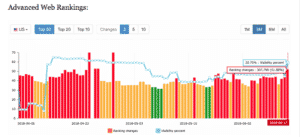
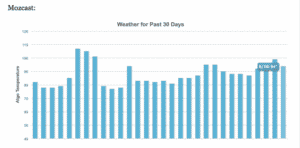
As you can see, there is substantial volatility. Additionally, we can see in metric from Mozcast that there have been substantial shifts in SERP related metrics:


The increase in domain diversity could mean that a higher number of different domains are appearing per search. If a site held multiple ranked positions for a term this could see them losing search visibility as a greater diversity of results are returned.
Sidebar: Google and other large online search providers have been called to account on how they produce search results. The proposed EU commission is set to force these tech giants to provide greater transparency around how search results are produced:
“It’s the first time the EU executive is proposing a regulation that targets large online platforms, but the new legislation reflects a sharpening of the Commission’s recent approach to tech giants. Last year, Brussels fined Google €2.4 billion for breaking competition rules to benefit its own shopping service over competitors.”
Additionally the European Union Google a record €2.4 billion after it was found guilty of manipulating its search engine results to expand its comparison shopping service. Read about it here from BussinessTech

Here we can see that the number of actual search results has dropped quite dramatically. Lately, you may have noticed that you are getting content directly in your search results rather than links to sites. This is an example of a change in the number of organic listings.
 Movements in the big 10:
Movements in the big 10:
Generally, there is a stable set of top ten sites that hold the best positions in search rankings. Shifts in these domains is usually a good indicator that something is on the move in the algorithm. These domains would include sites such as Wikipedia, Facebook, Amazon and Yelp.
If we look below, we can see that there has been a substantial change in these domains as of the 13th of June 2018. In correlation with the other data, this suggests that there is a change occurring in the Google search results algorithm and potentially search results pages structures.
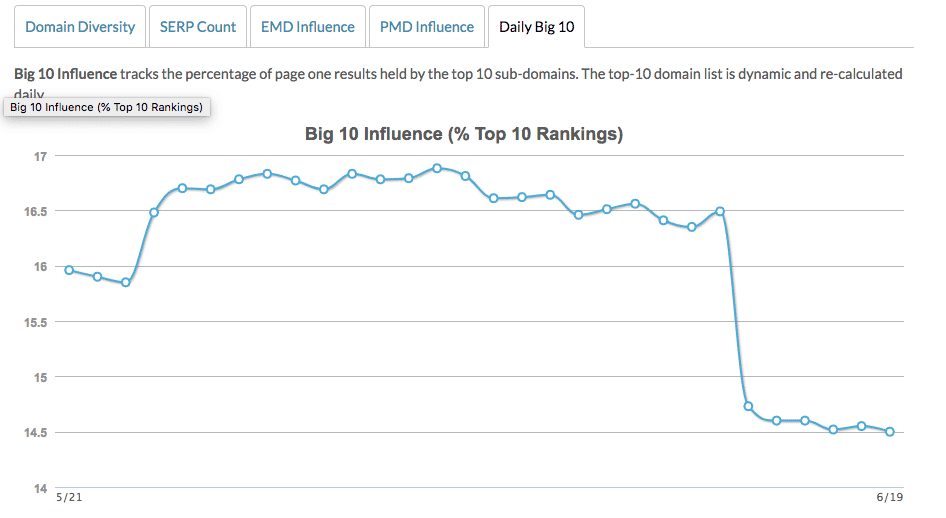

Here we did a very basic search for “videos of cats”:


All the results are specific to videos on YouTube rather than including any other sites that may include content specific to the search term. As you can understand, this shift in returned search results types can significantly impact your search rankings.
What’s next?
It’s clear that there are some major changes going on this year. In consideration of why one of the top possibilities could include the inception of the General Data Protection Regulation (GDPR) which was passed in the EU in 2017 and came into effect on the 25th May 2018. This regulation severely affects the way, type and use of any personal information regarding European citizens. The regulation does not only effect companies in Europe but any company processing European citizenry data.
As a result, we believe that Google has had to make dramatic changes to their policies and, potentially, the way they process ranking data.
However, that consideration is purely speculative. What we do know is that Google is giving preference to sites that:
- Have a great user experience and are fully mobile compatible
- Have diverse content that is useful and well structures
- Include schema and microdata for rich snippets and enhanced search results
- Focus on generating high-value links
So, if you place a high value on your organic traffic and it is a point of high return for your business you need to strongly consider a content production and site update process that brings you into the bare minimum of compliance with best practice.
As a last note, it is not just Google as a platform provider that is moving with great strides into exceptional mobile user experience and prioritizing high-value diverse content. Facebook announced in January of this year that they would be showing more peer-produced content over publisher content which made it more difficult for brands producing generic content to actually feature in a user’s home stream.
We will be watching the changes as they occur and feeding back to our clients and community on our opinion and insights into the ongoing changes not only on Google but in the online environment in general.
Here are some good readings for more information:
https://www.seroundtable.com/google-algorithm-update-signals-chatter-25915.html
https://www.mariehaynes.com/algo-changes-and-more/
https://moz.com/google-algorithm-change
https://webmasters.googleblog.com/2018/03/rolling-out-mobile-first-indexing.html
https://searchengineland.com/google-begins-rolling-out-mobile-first-indexing-to-more-sites-295095
https://www.gsqi.com/marketing-blog/march-7-2018-google-algorithm-update-brackets/
https://www.seroundtable.com/google-confirms-core-update-25390.html
https://www.seroundtable.com/google-search-ranking-algorithm-update-27077.html

